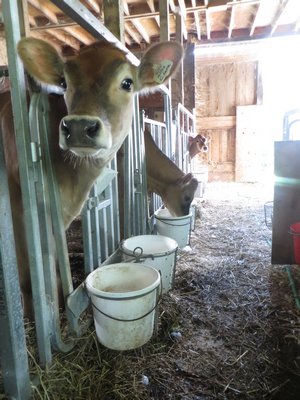

From fresh chicken sausages to sustainably sourced striped bass to raw milk to wine, the East End is a veritable bed of locally sourced food. From the fields we boast an array of produce like lacinato kale, watermelon radishes, fairytale eggplants, donut peaches or the specialty Milk Pail 95 apples. In the past decade, even wheat has been re-introduced to the food bed, thanks to Amber Waves and Carissa’s Bread. And now, with Wölffer Estate Vineyard’s gin and Sagaponack Farm Distillery’s potato vodka, there’s even locally produced liquor.
But we’re missing the big kahuna of the American diet: red meat.
Although livestock were traditionally raised on Long Island—in the heyday of the whaling industry, many farmers raised pigs for the ships leaving from Sag Harbor—the high cost of processing animals, from transport to man hours, means that many smaller farmers are discouraged from entering the market. There are a few operations scattered on the North Fork, but for red meat like cows or pigs, there is one small-scale producer on the South Fork: Mecox Bay Dairy. Others, like North Sea Farms in Noyac or Iacano Farm in East Hampton, raise and sell poultry products and eggs, which don’t require the same federal regulations for small-scale producers.
For East End meat producers, it is anywhere between a four- and five-hour drive to the nearest processing facility, usually in upstate New York, Connecticut or Pennsylvania. Pete Ludlow of Mecox Bay Dairy has heard of beef-only, halal processing facilities in New York City, but says, “the thought of driving the livestock trailer and the truck in New York City is enough for me.”
As it stands now, Mr. Ludlow leaves the Bridgehampton farm at 2 a.m. to avoid the metropolitan traffic, driving through New York City around 4 a.m. The whole trip, door-to-door, takes about 12 hours. In addition to a pick-up truck, he has a 16-foot trailer to transport the livestock. For the way back, he fits Styrofoam insulated panels into the sides, transforming the trailer into a refrigerated truck for the meat that they bring back. Mr. Ludlow estimates that the farm makes about five or six of these trips a year.
“It is an expensive rig,” said Mr. Ludlow, 30, who estimates that the trailer alone is around $14,000, without factoring in the gas, full size pickup truck and gooseneck hitch for the trailer. “You can transport two pigs in the back of a pickup truck, but you can’t transport a cow.”
Pointing out that Mecox Bay Dairy processes its own turkeys, thanks to a legal exception due to the small number of birds the dairy raises, he noted, “It doesn’t make sense that there is an exemption for poultry and there wouldn’t have been for red meat. It used to all be like that.”
Modern U.S. Department of Agriculture regulations mandate that animals must be processed at federally inspected facilities in order for their meat to be served at a restaurant or sold directly to consumers. Similar to the conglomeration of the dairy industry in the 1950s and 1960s following federal mandates for pasteurization, the USDA regulations for meat have pushed many small-scale producers out.
In 1967, there were 9,627 slaughterhouses in the United States, according to Bloomberg. When the Wholesome Meat Act was passed that same year, producers were required to use USDA-inspected facilities if they crossed state lines. That, coupled with the consolidation of the meat industry—today just four companies sell 85 percent of American beef—means that by 2016, there were only 1,100 slaughtering facilities in the country.
“What the hell sense does it make when you have folks like the Ludlows raising their animals two miles away from the restaurant having to do a multi-hour round-trip to the nearest slaughterhouse?” asked Jason Weiner, the executive chef at Almond, in an email. “Just so we can serve their beef and pork at the restaurant down the road from the farm. It’s a freaking obstacle course … it’s ridiculous.”
Other local chefs committed to the burgeoning food community on the East End echo Mr. Weiner’s sentiment.
“It is the big hole in the market right now, with Dock-to-Dish and the local seafood,” said Liza Tremblay, of Jo and Liza’s Ice Cream and Bay Burger restaurant in Sag Harbor. “It is so easy to get a wide variety of local produce.”
Ms. Tremblay sources all of the milk for Jo and Liza’s Ice Cream, as well as the grass-fed beef for Bay Burger, from the Hudson Valley. She’d be interested in buying meat locally from the East End, but since it isn’t widely available, the wholesale cost remains too high for an $8 burger.
However, there seems to be a solution close at hand. Tucked near the expressway in Yaphank, there is a former processing facility that is now sitting vacant, after being operated by the Cornell Cooperative Extension as a butcher-training facility for prisoners in nearby jails.
The county put out a request for proposal (RFP) last year for the slaughterhouse and received only one bid, which also requested that the surrounding lands—nearly 123 acres—be included. Since the additional lands were not offered publicly, the county decided to go back to the drawing board and offer a new RFP this year, with the possibility of including the extra acreage.
“We are exploring the widest possible options here,” said Auggie Ruckdeschel, an economic development specialist for Suffolk County, referencing the current RFP for the Yaphank facility. “We do see the meat processing facility itself as a means of economic development for the region.”
With proposals due by September 15, local producers only have one thing left to do: wait. Mr. Ruckdeschel estimates the facility could process up to 5,000 animals a year, which would be a boon to the industry.
“The way this works, we can’t do this ourselves,” said Mr. Ludlow, who hopes that in the future, there are more options available closer to home.
 More Posts from Alexandra Talty
More Posts from Alexandra Talty